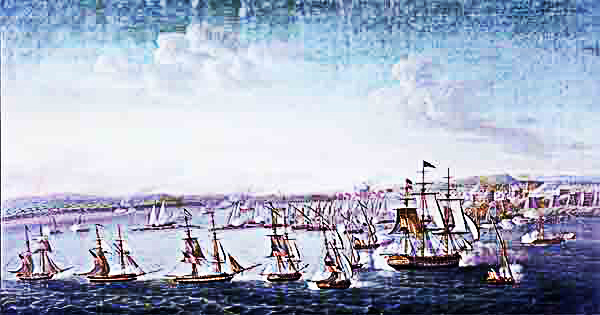
First Barbary War: Barbary pirates of Tripoli declare war on the United States of America on May 10, 1801
First Barbary War: Barbary pirates of Tripoli declare war on the United States of America: During the First Barbary War, U.S. Lieutenant Stephen Decatur leads a military mission that famed British Admiral Horatio Nelson calls the “most daring act of the age.”
In June 1801, President Thomas Jefferson ordered U.S. Navy vessels to the Mediterranean Sea in protest of continuing raids against U.S. ships by pirates from the Barbary states - Morocco, Algeria, Tunis and Tripolitania. American sailors were often abducted along with the captured booty and ransomed back to the United States at an exorbitant price. After two years of minor confrontations, sustained action began in June 1803 when a small U.S. expeditionary force attacked Tripoli harbor in present-day Libya.
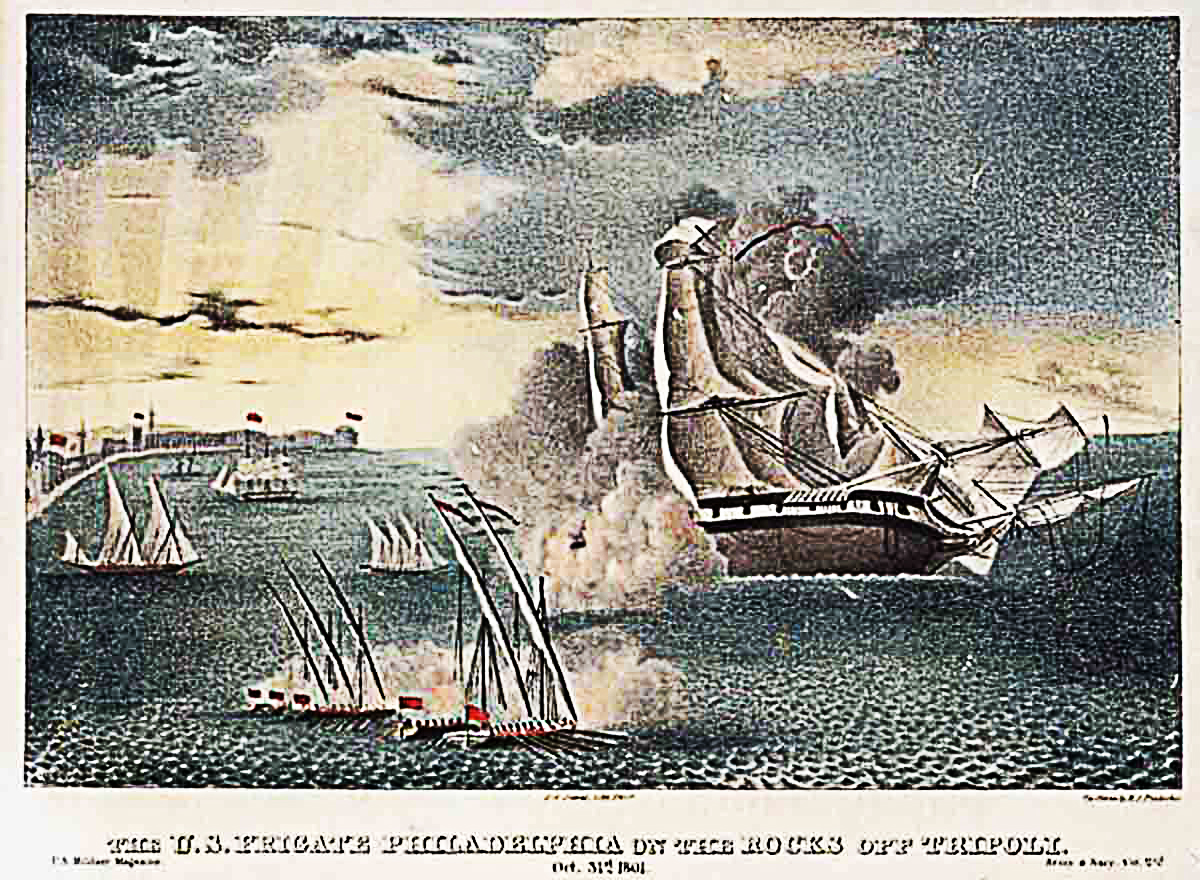
In October 1803, the U.S. frigate Philadelphia ran aground near Tripoli and was captured by Tripolitan gunboats. The Americans feared that the well-constructed warship would be both a formidable addition to the Tripolitan navy and an innovative model for building future Tripolitan frigates. Hoping to prevent the Barbary pirates from gaining this military advantage, Lieutenant Stephen Decatur led a daring expedition into Tripoli harbor to destroy the captured American vessel on February 16, 1804.
After disguising himself and his men as Maltese sailors, Decatur’s force of 74 men, which included nine U.S. Marines, sailed into Tripoli harbor on a small two-mast ship. The Americans approached the USS Philadelphia without drawing fire from the Tripoli shore guns, boarded the ship, and attacked its Tripolitan crew, capturing or killing all but two. After setting fire to the frigate, Decatur and his men escaped without the loss of a single American. The Philadelphia subsequently exploded when its gunpowder reserve was lit by the spreading fire.
Six months later, Decatur returned to Tripoli Harbor as part of a larger American offensive and emerged as a hero again during the so-called “Battle of the Gunboats”, a naval battle that saw hand-to-hand combat between the Americans and the Tripolitans.
History Channel / Wikipedia / Encyclopedia Britannica
Monticello.org / Office Of The Historian.gov / Mariners' Museum.org /
Library Of Congress / National Archives.gov / Battlefields.org /
First Barbary War: Barbary pirates of Tripoli declare war on the United States of America on May 10, 1801 (YouTube) 

An expedition led by Captain Christopher Newport arrives at Jamestown on May 13, 1607
An expedition led by Captain Christopher Newport arrived at Jamestown: The next day, the passengers went ashore and this site became the first permanent settlement English colony in America.
On May 13, 1607 three English ships the Susan Constant, Godspeed and Discovery with approximately 144 settlers and sailors, will land and plant the first permanent English colony in North America. Established by the Virginia Company of London this settlement would be called Jamestown, after king James I.
On June 15, 1607 the fleet commander Captain Christopher Newport will return to England leaving 104 settlers.
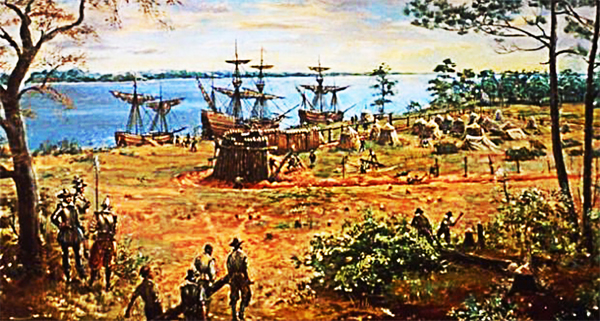
Long before the English colonists reached Virginia in 1607, they incarcerated their first prisoner - John Smith. He was too outspoken during the beginnings of the journey from London to Virginia. After the three-vessel expedition resupplied at the Canary Islands, the other leaders of the expedition accused Smith of mutiny.
Smith wrote later that he was “restrained as a prisoner” for the last 13 weeks of the trip from the Canary Islands, so the first prison in Virginia was a cabin on the Susan Constant as it sailed into the Chesapeake Bay. In the close quarters of the ships during an ocean journey, “restraint” may have consisted of a loss of status and shunning by the leaders who had tired of hearing his advice, but he could have been shackled in a cabin. According to Smith, he was able to communicate to others on the ship that he was being treated unfairly.
After arriving in the New World, the unhappy leaders did not mellow in their attitude towards John Smith. Captain Christopher Newport decided to hang Smith when the three ships reached the island of Nevis. Smith reported with wry understatement later that:
“...a pair of gallows were made, but Captain Smith for whom they were intended, could not be persuaded to use them.”
Smith may owe his life to the intercession of other leaders on the journey. Captain Christopher Newport had been given exclusive command during the trip across the Atlantic Ocean, and while on Nevis no one knew who would be appointed to the Council that would govern once the colony was established, but key leaders such as Bartholomew Gosnold must have known that Smith had been recruited by the Virginia Company of London for his military skills. Newport had the authority as sole leader during the ocean journey phase to execute a mutineer, but was evidently persuaded to show mercy.
Smith remained estranged from the other colonial leaders in Virginia until June 10, when he was finally released from the Susan Constant, the first prison in Virginia. Smith was given the seat on the council assigned to him in the instructions that had been prepared by the Virginia Company in London in 1606.
On June 22, Christopher Newport took the Susan Constant back to England, and the Godspeed accompanied him. The smallest vessel, the pinnace Discovery, was left behind in Virginia. It ended up as the second prison in the colony.
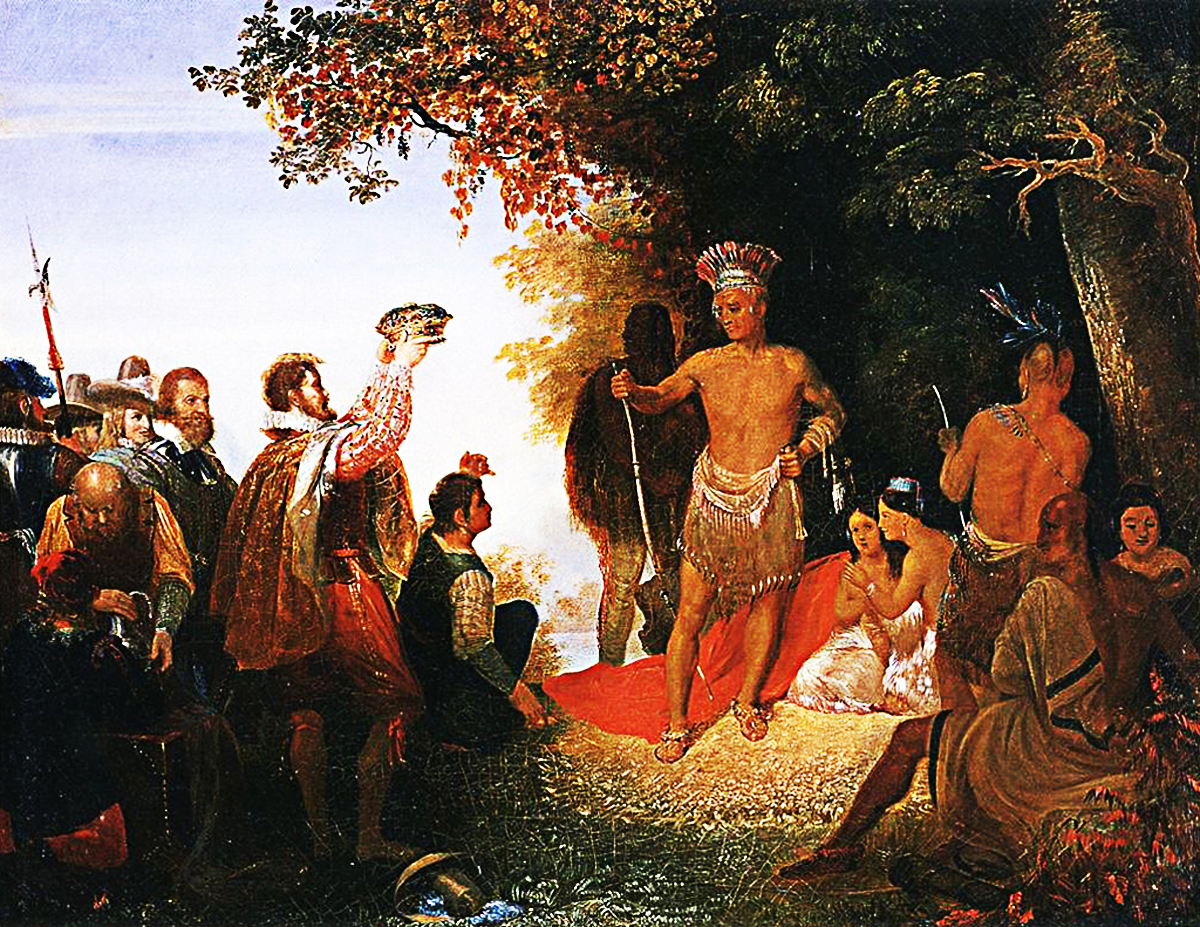
Though Virginia Company leaders were able to lock up the blacksmith and Native Americans briefly on land and keep Wingfield/Kendall incarcerated on a ship, they were unable to keep colonists from wandering away from the fort or leaving the peninsula. Powhatan benefitted from colonists willing to trade supplies stolen from the Virginia Company storehouses, and from deserters who brought him intelligence, tools, and even weapons. The loss of supplies ended only after Smith placed a blockhouse to control passage across the narrow peninsula
In addition to arresting each other, the council did order the seizure of Native Americans and keep them within the walls of the fort at Jamestown. In the spring of 1608, the colonists were frustrated by steady pilfering items made of iron and copper, and by intermittent attacks on individuals or groups who left the safety of the fort. The English seized a dozen men one day, adding to four or five already being held as punishment for some sort of offenses.
In response, the Native Americans around the fort captured two men who had been gathering food. John Smith reacted by leading a force on the barge to various settlements along the James River, burning towns and destroying canoes. The English also separated the captives and fooled them into thinking their friends were being executed.
After three days, Powhatan sent messengers (including Pocahontas) to request the release of his men. The colonists let them go, thinking that the Native Americans had been intimidated sufficiently. The alternative was to execute the prisoners, or to whip them and let them go. There was no space in which to restrain them indefinitely, and not enough food to feed long-term prisoners. After the short imprisonment, the small-scale attacks stopped briefly.
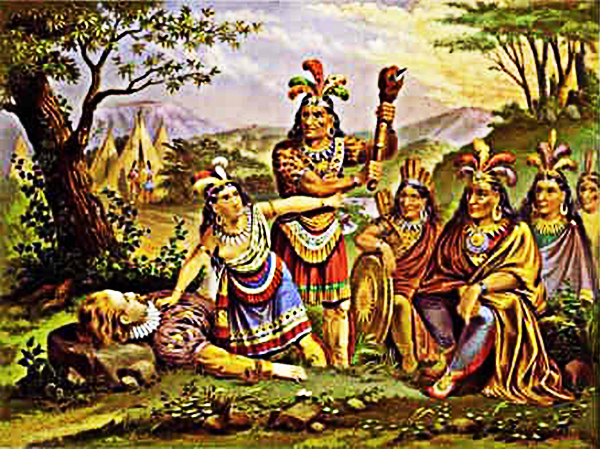
During the Starving Time in the winter of 1609-10, Virginia Company officials at Jamestown had to deal with murder and cannibalism. Punishment came quickly after recognition of the crime; there was no consideration of long-term incarcertation. George Percy, president of the council at the time, wrote:
“...one of our colony murdered his wife, ripped the child out of her womb and threw it into the river, and after chopped the mother in pieces and salted her for his food... for the which cruel and inhumane fact I ajudged him to be executed, the acknowledgement of the deed being enforced from him by torture having hung by the thumbs with weights at his feet a quarter of an hour before he would confess...”
In 1610, Percy was faced with the challenge of incarcerating captured members of the Paspahegh tribe. That problem was solved by killing the prisoners, eliminating the need for using any structure as a prison.
Percy led an expedition against the Paspahegh tribe, living just upstream of Jamestown, after Sir Thomas Gates finally arrived from Bermuda and took charge of the colony. The English raiders captured several Paspahegh men, plus the queen and two children. The men were killed, but the queen and children were loaded on the boat to be carried back to Jamestown.
On the trip back downstream, the English threw the two children overboard into the James River and used them for target practice. Percy “had mutche to doe To save the quenes lyfe” and bring her alive to Jamestown.
Once there, Sir Thomas Gates decided he did not want her as a hostage. He directed that she should be burnt alive rather than kept alive as a prisoner requiring food and guards. Rather than follow the suggestion, Percy had the queen executed by sword thrusts. It may have been a more-humane technique than burning, but was equally effective in eliminating the need for a prison.
Virginia Places.org / Wikipedia / Encyclopedia Britannica /
Exploration Mariners Museum.org / National Parks Service.gov / Jamestown Settlement, Early - Encyclopedia Virginia.org /
An expedition led by Captain Christopher Newport arrives at Jamestown on May 13, 1607 (YouTube) 
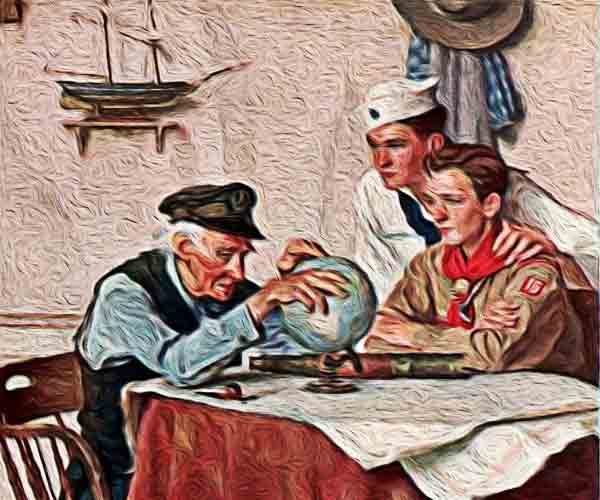
Understanding Military Terminology
Redeployment
(DOD) The transfer or rotation of forces and materiel to support another joint force commander’s operational requirements, or to return personnel, equipment, and materiel to the home and/or demobilization stations for reintegration and/or out-processing.
See also Deployment.
Joint Publications (JP 3-35) Deployment and Redeployment Operations
Red Team
(DOD) An organizational element comprised of trained and educated members that provide an independent capability to fully explore alternatives in plans and operations in the context of the operational environment and from the perspective of adversaries and others.
Joint Publications (JP 2-0) Deployment and Redeployment Operations
Reduced Operating Status
(DOD) Military Sealift Command ships withdrawn from full operating status because of decreased operational requirements.
Also called ROS.
See also Military Sealift Command.
Joint Publications (JP 4-01.2) Joint Tactics, Techniques and Procedures for Sealift Support to Joint Operations
Reduction
(DOD) The creation of lanes through a minefield or obstacle to allow passage of the attacking ground force.
Joint Publications (JP 3-15) Barriers, Obstacles, and Mine Warfare for Joint Operations
Joint Publication - Department of Defense Dictionary of Military and Associated Terms
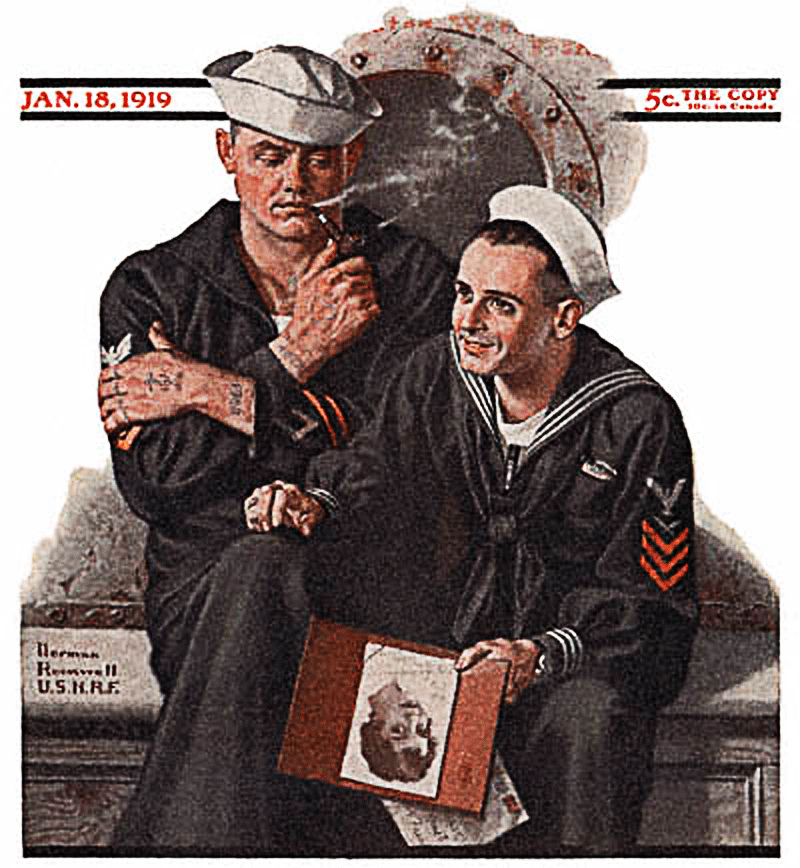
The Old Salt’s Corner
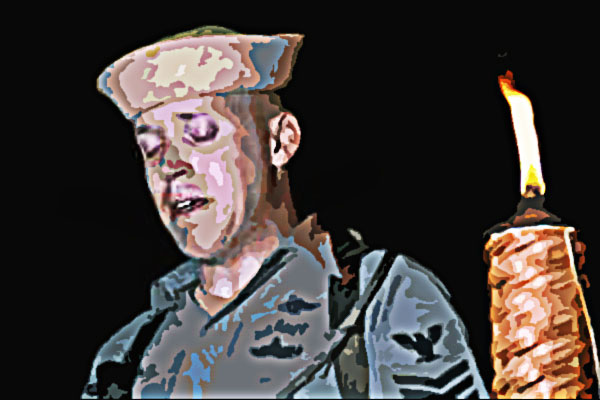
“WHO LOVED SO WELL”
(A sailor's eulogy)
We sailed the sea by oceans light,
Around the horn through restless night.
Our course and luck did make it right,
To see things new in strange delight.
The seas were harsh and took their toll
With branded flesh and tortured soul.
And when at last the sun sat low,
It touched the earth with blood red glow.
The mighty wars have all been won.
Now empty winds slack sails undone.
The world is ours but mates care not,
And search in vain for wars unfought.
Silver breakers plight our trough,
To sails unfurled and winds aloft.
Spirits soar on breezes free,
That bear the souls of sailors we.
Hear our prayer Oh Lord our God.
We lived to serve and wield thy rod.
Though wretches we and racked with flaws,
We are the ones who fought thy cause.
Now bleached white bones on foreign sands,
Attest the toll in far off lands,
For those who heard their country's call,
Brave sailors each, who came to fall.
Remember those who served on ships,
And bid farewell on endless trips,
Across the seas to Timbuktu,
And lived and died, these chosen few.
We ask this, Lord, for those so true,
And honor bound beneath skies blue.
Who served and died for freedom's hand,
To hold and cherish this, your land.
A sailor's death on ships of sleep,
With few to know and none to weep.
For faith so brave, a soul to keep,
A silent grave in oceans deep.
And when the end has come at last,
And unfilled shadows heaven casts.
Remember we who served and fell,
And to the hosts of heaven tell.
Bring home my boys who loved so well.
~ (Robert E. Browne CPO, USN, ret.)

“I’m Just Sayin”
“Put your ear down close to your soul and listen hard.”
“The joy that isn't shared dies young.”
“Even without wars, life is dangerous.”
“Need is not quite belief.”
“In a dream you are never eighty.”
“Death's in the good-bye.”
“It doesn't matter who my father was,
it matters who I remember he was.”
“Live or die,
but don't poison everything.”
“Madness is a waste of time.
It creates nothing.”
~ Anne Sexton

“Thought for the Day”
“Fortune befriends the bold.”
“Saying nothing... sometimes says the most.”
“Beauty is not caused. It is.”
“That it will never come again is what makes life sweet.”
“It is better to be the hammer than the anvil.”
“A wounded deer leaps the highest.”
“Dogs are better than human beings because they know but do not tell.”
“He ate and drank the precious Words,
his Spirit grew robust;
He knew no more that he was poor,
nor that his frame was Dust.”
~ Emily Dickinson

“What I Learned”
“To say ‘I love you’ one must first be able to say the ‘I’.”
“The worst guilt is to accept an unearned guilt.”
“The question isn't who is going to let me;
it's who is going to stop me.”
“A creative man is motivated by the desire to achieve,
not by the desire to beat others.”
“The smallest minority on earth is the individual.
Those who deny individual rights cannot claim to be defenders of minorities.?”
“I swear,
by my life and my love of it,
that I will never live for the sake of another man,
or ask another man to live for mine.”
“We are fast approaching the stage of the ultimate inversion:
the stage where the government is free to do anything it pleases,
while the citizens may act only by permission;
which is the stage of the darkest periods of human history,
the stage of rule by brute force.”
~ Ayn Rand
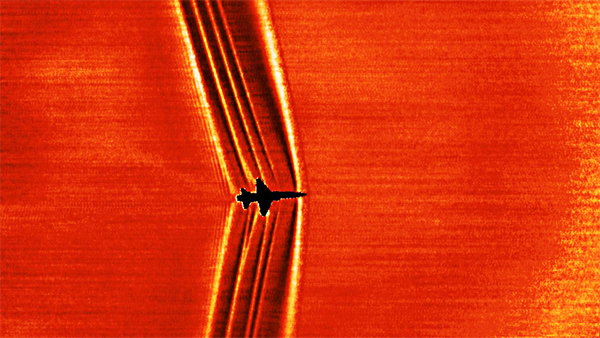
Mr. Answer Man Please Tell Us: What is a Sonic Boom?
A sonic boom is the sound associated with the shock waves created whenever an object travelling through the air travels faster than the speed of sound. Sonic booms generate enormous amounts of sound energy, sounding similar to an explosion or a thunderclap to the human ear. The crack of a supersonic bullet passing overhead or the crack of a bullwhip are examples of a sonic boom in miniature.
Sonic booms due to large supersonic aircraft can be particularly loud and startling, tend to awaken people, and may cause minor damage to some structures. They led to prohibition of routine supersonic flight over land. Although they cannot be completely prevented, research suggests that with careful shaping of the vehicle the nuisance due to them may be reduced to the point that overland supersonic flight may become a practical option.
A sonic boom does not occur only at the moment an object crosses the speed of sound; and neither is it heard in all directions emanating from the speeding object. Rather the boom is a continuous effect that occurs while the object is travelling at supersonic speeds. But it only affects observers that are positioned at a point that intersects a region in the shape of a geometrical cone behind the object. As the object moves, this conical region also moves behind it and when the cone passes over the observer, they will briefly experience the boom.
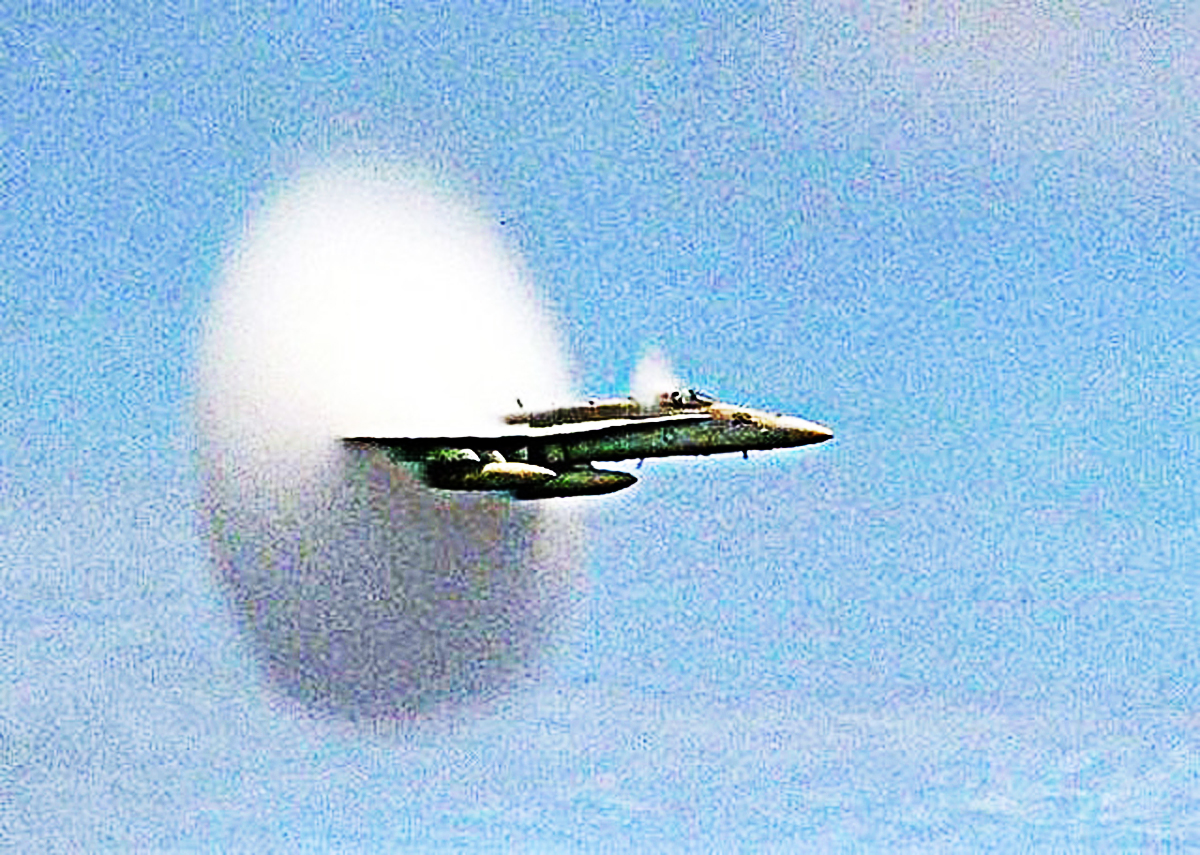
Causes
When an aircraft passes through the air it creates a series of pressure waves in front of the aircraft and behind it, similar to the bow and stern waves created by a boat. These waves travel at the speed of sound and, as the speed of the object increases, the waves are forced together, or compressed, because they cannot get out of each other's way quickly enough. Eventually they merge into a single shock wave, which travels at the speed of sound, a critical speed known as Mach 1, and is approximately 1,235 km/h (767 mph) at sea level and 20 °C (68 °F).
In smooth flight, the shock wave starts at the nose of the aircraft and ends at the tail. Because the different radial directions around the aircraft's direction of travel are equivalent (given the “smooth flight” condition), the shock wave forms a Mach cone, similar to a vapour cone, with the aircraft at its tip. The half-angle between direction of flight and the shock wave.
There is a rise in pressure at the nose, decreasing steadily to a negative pressure at the tail, followed by a sudden return to normal pressure after the object passes. This “overpressure profile” is known as an N-wave because of its shape. The “boom” is experienced when there is a sudden change in pressure; therefore, an N-wave causes two booms – one when the initial pressure-rise reaches an observer, and another when the pressure returns to normal. This leads to a distinctive "double boom" from a supersonic aircraft. When the aircraft is maneuvering, the pressure distribution changes into different forms, with a characteristic U-wave shape.
Since the boom is being generated continually as long as the aircraft is supersonic, it fills out a narrow path on the ground following the aircraft's flight path, a bit like an unrolling red carpet, and hence known as the boom carpet. Its width depends on the altitude of the aircraft. The distance from the point on the ground where the boom is heard to the aircraft depends on its altitude and the angle.
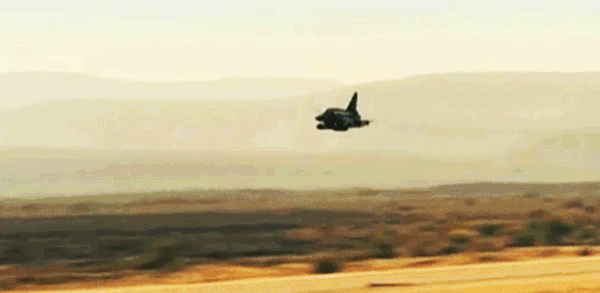
Perception, noise and other concerns
The sound of a sonic boom depends largely on the distance between the observer and the aircraft shape producing the sonic boom. A sonic boom is usually heard as a deep double “boom” as the aircraft is usually some distance away. However, as those who have witnessed landings of space shuttles have heard, when the aircraft is nearby the sonic boom is a sharper “bang” or “crack”.
The sound is much like that of mortar bombs, commonly used in firework displays. It is a common misconception that only one boom is generated during the subsonic to supersonic transition; rather, the boom is continuous along the boom carpet for the entire supersonic flight. As a former Concorde pilot puts it, “You don't actually hear anything on board. All we see is the pressure wave moving down the aeroplane - it gives an indication on the instruments. And that's what we see around Mach 1.
But we don't hear the sonic boom or anything like that. That's rather like the wake of a ship - it's behind us”.
In 1964, NASA and the Federal Aviation Administration began the Oklahoma City sonic boom tests, which caused eight sonic booms per day over a period of six months. Valuable data was gathered from the experiment, but 15,000 complaints were generated and ultimately entangled the government in a class action lawsuit, which it lost on appeal in 1969.
There has been recent work in this area, notably under DARPA's Quiet Supersonic Platform studies. Research by acoustics experts under this program began looking more closely at the composition of sonic booms, including the frequency content. Several characteristics of the traditional sonic boom “N” wave can influence how loud and irritating it can be perceived by listeners on the ground. Even strong N-waves such as those generated by Concorde or military aircraft can be far less objectionable if the rise time of the overpressure is sufficiently long. A new metric has emerged, known as perceived loudness, measured in PLdB. This takes into account the frequency content, rise time, etc. A well-known example is the snapping of one's fingers in which the “perceived” sound is nothing more than an annoyance.
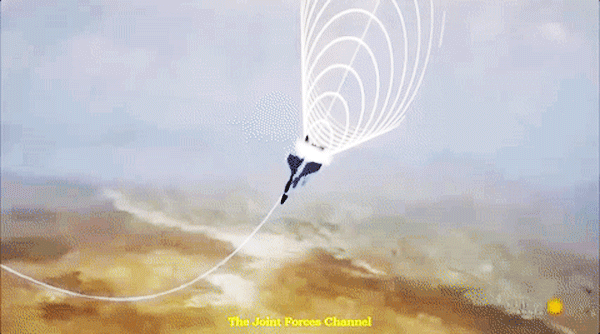
Bullwhip
The cracking sound a bullwhip makes when properly wielded is, in fact, a small sonic boom. The end of the whip, known as the “cracker”, moves faster than the speed of sound, thus creating a sonic boom. The whip is probably the first human invention to break the sound barrier.
A bullwhip tapers down from the handle section to the cracker. The cracker has much less mass than the handle section. When the whip is sharply swung, the energy is transferred down the length of the tapering whip. Goriely and McMillen showed that the physical explanation is complex, involving the way that a loop travels down a tapered filament under tension
NASA
• Encyclopedia Britannica
• Lockheed Martin
• Quora
• Wikipedia
/ What is a Sonic Boom? (YouTube) 

NAVSPEAK aka U.S. Navy Slang
UA: Unauthorized absence: (Navy term for) AWOL.
Uncle Sam's Canoe Club: The United States Coast Guard.
Uncle Sam's Confused Group (USCG): The United States Coast Guard. So called because it is the 5th branch of the armed forces, yet falls under the control of the Department of Homeland Security.
Uncle Sam's Misguided Children (USMC): The Marines.
Underway Sock: See “Cruise sock”.
UNODIR: Unless Otherwise Directed; enables trust-based management by exception (MBE).
Unicorn: An officer with a particularly rare designator (i.e. METOC).
UNREP: Underway Replenishment: The taking of supplies from a supply ship by maneuvering alongside it and passing lines between it and one's own vessel. Differs from “VERTREP”.
UNSAT: Unsatisfactory: Below standards.
Wiktionary.org

Just for you MARINE
UA: Unauthorized Absence, the naval version of the term AWOL.
UCMJ: Uniform Code of Military Justice (Public Law 506, 81st Congress) 1951, the system of military law, both judicial and non-judicial.
UD: Unit Diary, the computerized system that maintains all administrative records for a unit. Also, Uniform of the Day (or UDs) – prescribed uniform for the day; more generally associated with “Charlies”
Un-fuck: To correct a deficiency, usually on a person.
Under Arms: Status of having a weapon, sidearm, “MP” or “SP” brassard, or wearing equipment pertaining to an arm such as a sword sling, pistol belt, or cartridge belt as part of guard duty; Marines under arms do not remove covers indoors.
Under Canvas: Living under temporary sheltering, such as a tent.
Under Way: To depart or to start a process for an objective.
UNQ: Unqualified, usually in reference to training events. Pronounced “"unk”.
Unsat: Abbreviation of unsatisfactory.
Wikipedia.org
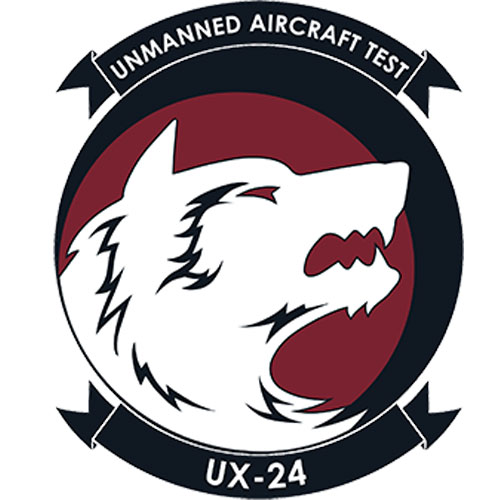
Naval Aviation Squadron Nicknames
UX-24 Naval Aviation Squadron Nicknames: Unmanned Aerial Systems (UAS) Squadrons (UX) Squadron TWO FOUR - nicknamed the “Unmanned Aircraft Test”
United States Navy - Unmanned Aircraft Systems Test Directorate - Naval Outlying Field Webster (NOLF Webster), West of St. Inigoes, Maryland. / UX-24: October 17, 2018 - present
Wikipedia.org

Where Did That Saying Come From?

“Another day, another dollar:”
Meaning: The proverbial phrase “another day, another dollar” is a weary resignation that the day to come will be one of tedious work, the only benefit being the small amount of payment at the end of it.
History: “Another day, another dollar” began as a sailor's expression in the USA in the 19th century. It dates from the days when sailors were paid a dollar a day.
On long voyages each day was similar to the last and all that the seamen had to show for a day's work was one more dollar in their pocket
Joseph Conrad referred to the form of payment in his seafaring novel “The [N-word] of the ‘Narcissus’ A Tale of the Forecastle” (sometimes subtitled “A Tale of the Sea”), 1897:
The common saying, “More days, more dollars”, did not give the usual comfort because the stores were running short.”
Conrad was a successful novelist and the currently used form of the expression soon started appearing in other places. A story entitled “Gittin' up time” was reprinted in several U.S. newspapers in March 1907, including the Logansport (Indiana) Daily Reporter:
I sat up and stretched and yawned “Oh hum! The same old grind. Another day, another dollar.”
The proverb has long since lost its nautical connections and is now used worldwide as an ironic and weary resignation marking the start of another unremarkable working day.
Phrases.org.uk

Science & Technology

FEATURED: Scientists discover gut bacteria that improve memory in bees
• Novel color photography using a high-efficiency probe can super-focus white light into a 6-nanometer spot
New ultrahard diamond glass synthesized
• Arctic Ocean started getting warmer decades earlier than we thought, study finds
• Extraordinary Roman mosaic and villa discovered beneath farmer's field in Rutland, UK
We might not know half of what's in our cells, new AI technique reveals
• Unveiling the hidden cellular logistics of memory storage in neurons
• Antibodies mimicking the virus may explain long haul COVID-19, rare vaccine side effects
Targeted drug combination shows unprecedented activity in some highly aggressive brain tumors
• Enhancing the workhorse: Artificial intelligence, hardware innovations boost confocal microscope's performance
• On-chip frequency shifters in the gigahertz range could be used in next generation quantum computers and networks
Phys.org / MedicalXpress / TechXplore
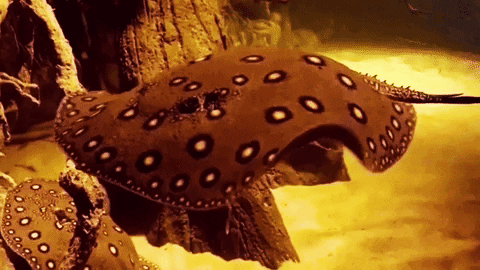
FEATURED: Soft artificial electroreceptors for noncontact spatial perception - Elasmobranch fishes, such as sharks, skates, and rays, use a network of electroreceptors distributed on their skin to locate adjacent prey
• Small-molecule antagonism of the interaction of the RAGE cytoplasmic domain with DIAPH1 reduces diabetic complications in mice
How the jerboa got its enormous feet
• Leading breeder of beagles for research slammed by animal welfare inspectors
Why are trees dropping so many nuts? Climate may drive erratic “masting”
• Pesticides can harm bees twice—as larvae and adults
House science committee chair leaves bipartisan legacy as she bids farewell
• Next generation of deep brain stimulation aims to tackle depression
Science AAAS

Bizarre News (we couldn’t make up stuff this good - real news story)
Largest comet ever observed was active at near-record distance
Source: University of Maryland
Summary: Astronomers show that comet Bernardinelli-Bernstein (BB), the largest comet ever discovered, was active long before previously thought, meaning the ice within it is vaporizing and forming an envelope of dust and vapor known as a coma. Only one active comet has been observed farther from the sun, and it was much smaller than comet BB.

A new study by University of Maryland astronomers shows that comet Bernardinelli-Bernstein (BB), the largest comet ever discovered, was active long before previously thought, meaning the ice within it is vaporizing and forming an envelope of dust and vapor known as a coma. Only one active comet has been observed farther from the sun, and it was much smaller than comet BB.
The finding will help astronomers determine what BB is made of and provide insight into conditions during the formation of our solar system. The finding was published in The Planetary Science Journal on November 29, 2021.
“These observations are pushing the distances for active comets dramatically farther than we have previously known”, said Tony Farnham, a research scientist in the UMD Department of Astronomy and the lead author of the study.
Knowing when a comet becomes active is key to understanding what it's made of. Often called “dirty snowballs” or “icy dirtballs”, comets are conglomerations of dust and ice left over from the formation of the solar system. As an orbiting comet approaches its closest point to the sun, it warms, and the ices begin to vaporize. How warm it must be to start vaporizing depends on what kind of ice it contains (e.g., water, carbon dioxide, carbon monoxide or some other frozen compound).
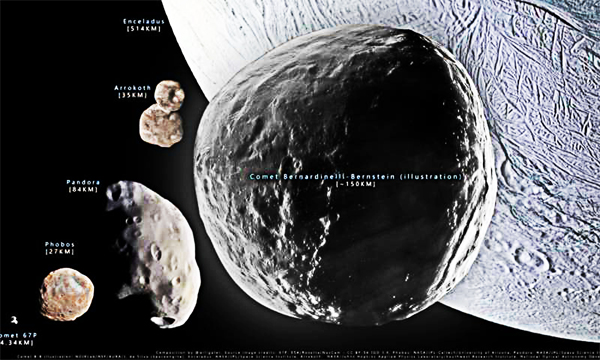
Scientists first discovered comet BB in June 2021 using data from the Dark Energy Survey, a collaborative, international effort to survey the sky over the Southern hemisphere. The survey captured the bright nucleus of the comet but did not have high-enough resolution to reveal the envelope of dust and vapor that forms when the comet becomes active.
At 100 km across, comet BB is the largest comet ever discovered by far, and it is farther from the sun than the planet Uranus. Most comets are around 1 km or so and much closer to the sun when they are discovered. When Farnham heard about the discovery, he immediately wondered if images of comet BB had been captured by the Transient Exoplanet Survey Satellite (TESS), which observes one area of the sky for 28 days at a time. He thought TESS's longer exposure times could provide more detail.
Farnham and his colleagues combined thousands of images of comet BB collected by TESS from 2018 through 2020. By stacking the images, Farnham was able to increase the contrast and get a clearer view of the comet. But because comets move, he had to layer the images so that comet BB was precisely aligned in each frame. That technique removed the errant specks from individual shots while amplifying the image of the comet, which allowed researchers to see the hazy glow of dust surrounding BB, proof that BB had a coma and was active.

To ensure the coma wasn't just a blur caused by the stacking of images, the team repeated this technique with images of inactive objects from the Kuiper belt, which is a region much farther from the sun than comet BB where icy debris from the early solar system is plentiful. When those objects appeared crisp, with no blur, researchers were confident that the faint glow around comet BB was in fact an active coma.
The size of comet BB and its distance from the sun suggests that the vaporizing ice forming the coma is dominated by carbon monoxide. Since carbon monoxide may begin to vaporize when it is up to five times farther away from the sun than comet BB was when it was discovered, it is likely that BB was active well before it was observed.
“We make the assumption that comet BB was probably active even further out, but we just didn't see it before this”, Farnham said. “What we don't know yet is if there's some cutoff point where we can start to see these things in cold storage before they become active.”
According to Farnham, the ability to observe processes like the formation of a cometary coma farther than ever before opens an exciting new door for astronomers.
“This is just the beginning”, Farnham said. “TESS is observing things that haven't been discovered yet, and this is kind of a test case of what we will be able to find. We have the potential of doing this a lot, once a comet is seen, going back through time in the images and finding them while they are at farther distances from the sun.”
Related: Farthest Active Inbound Comet Yet Seen
Unique Type of Object Discovered in Our Solar System
Phoenicid Meteor Shower from Dead Comet Arises Again After 58 Years
Micro Spacecraft Investigates Cometary Water Mystery
Additional Resources: Largest Comet Ever Observed Was Active at Near-Record Distance
In the Quantum Realm, Not Even Time Flows as You Might Expect
Orbital Harmony Limits Late Arrival of Water on TRAPPIST-1 Planets
Science Daily (11/29/2021) 


SONG FACTS
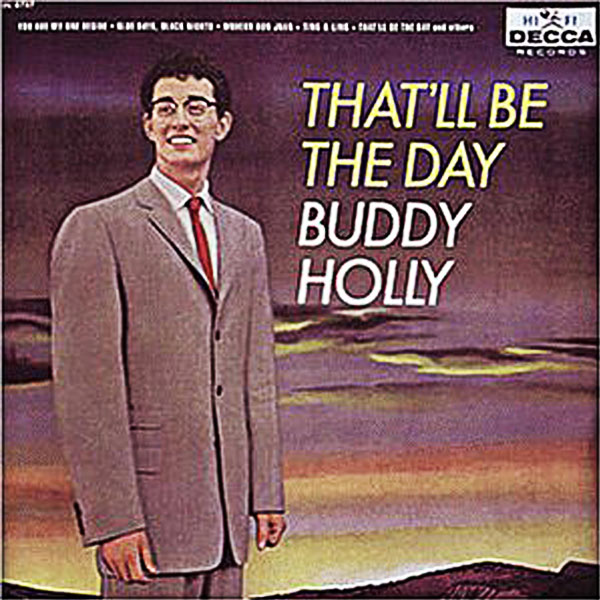
“That'll Be the Day”  - Buddy Holly
- Buddy Holly
Album: That'll Be The Day [1957]
Released 1956 
Buddy Holly had been kicking around his home town in Lubbock, Texas trying to write a hit song for his small rockabilly band since he had attended an Elvis Presley gig at his High School some time in 1955.
His band in those days consisted of him on lead vocals and guitar, Jerry Allison on the drums and Joe B. Maudlin on upright bass. He and Jerry decided to get together and go see
“The Searchers”  , a Western movie staring John Wayne.
, a Western movie staring John Wayne.
In the movie, Wayne keeps replying, “That'll be the day”, every time another character in the film predicts or proclaims something will happen when he felt it was not likely to happen.
The phrase stuck in Jerry's mind, and when they were hanging out at Jerry's house one night, Buddy looked at Jerry and said that it sure would be nice if they could record a hit song. Jerry replied with, “That'll be the day”, imitating John Wayne in the film.
Holly and his band “The Three Tunes” recorded
“That'll Be the Day”  in Nashville in 1956,but Decca records didn't like the result and refused to release it.
in Nashville in 1956,but Decca records didn't like the result and refused to release it.
A year later, Holly re-recorded it with The Crickets in a studio in Clovis, New Mexico owned by his new producer, Norman Petty. Backup vocalists were brought in and the key was lowered to fit Holly's voice a little better.
This version became a huge hit and made Holly a star that summer.
Norman Petty took a writing credit on this because he produced it. This meant Holly and Allison had to share royalties with him.
This was Holly's first hit, but it was credited to The Crickets, Holly's band. They worked with two record labels, with one releasing Holly's songs as The Crickets and the other as Buddy Holly. Both labels were subsidiaries of Decca Records.
This inspired the British 1973 movie of the same name, about a young man with dreams of becoming a rock star.
This was the first song John Lennon learned to play on guitar. American rock stars like Holly and Little Richard were a big influence on The Beatles.
The movie that inspired Holly and Allison to write this also provided the name for the British group The Searchers in 1964.
When this became a hit, Decca records released Holly's earlier version as well.
“That'll Be the Day”  was the first song John Lennon, Paul McCartney and George Harrison recorded together.
In 1958, when they were still known as The Quarrymen, they pooled their money, recorded the song at a local studio, and pressed one copy on a 78rpm disc, which they shared.
The disc ended up in the possession of Duff Lowe, the piano player in group. In the early '80s, he sold it to McCartney; it was first heard in a 1985 documentary on Buddy Holly, and was released in 1995 on the
“Anthology 1 collection”
was the first song John Lennon, Paul McCartney and George Harrison recorded together.
In 1958, when they were still known as The Quarrymen, they pooled their money, recorded the song at a local studio, and pressed one copy on a 78rpm disc, which they shared.
The disc ended up in the possession of Duff Lowe, the piano player in group. In the early '80s, he sold it to McCartney; it was first heard in a 1985 documentary on Buddy Holly, and was released in 1995 on the
“Anthology 1 collection”  .
.
Linda Ronstadt released her version of
“That'll Be the Day”  as the lead single from her 1976 album “Hasten Down the Wind”.
This came at the suggestion of her producer, Peter Asher, who recorded the song completely live, just as Holly's version was done in the days before multitracking. The song went to #11 in the U.S. and marked a shift for Ronstadt away from country rock.
as the lead single from her 1976 album “Hasten Down the Wind”.
This came at the suggestion of her producer, Peter Asher, who recorded the song completely live, just as Holly's version was done in the days before multitracking. The song went to #11 in the U.S. and marked a shift for Ronstadt away from country rock.
On this version  ,
listen for the guitar solo - Waddy Wachtel played the first four bars, then Andrew Gold took over for the last four. Wachtel's performance helped raise his profile in the Los Angeles music scene, where he soon became one of the top session players.
,
listen for the guitar solo - Waddy Wachtel played the first four bars, then Andrew Gold took over for the last four. Wachtel's performance helped raise his profile in the Los Angeles music scene, where he soon became one of the top session players.
In the U.S., The Everly Brothers' version of
“That'll Be the Day”  reached #111 in 1965; Pure Prairie League took it to #106 in 1976.
reached #111 in 1965; Pure Prairie League took it to #106 in 1976.
MORE SONGS
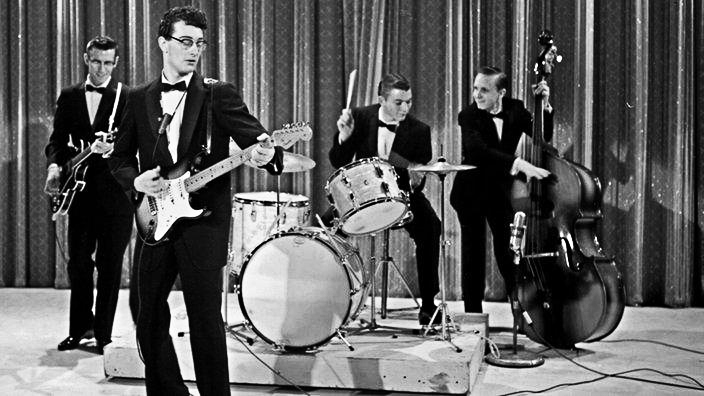
“That'll Be the Day” (1956) 
“Love Me” (1956) 
“Not Fade Away” (1956) 
“Peggy Sue” (1957) 
“Oh, Boy!” (1957) 
&ldquoI'm Looking for Someone to Love” (1957) 
“You've Got Love” (1957) 
“Rock Me Baby” (1957) 
“Maybe Baby” (1958) 
“Words of Love” (1958) 
“Rave On” (1958) 
“Think It Overy” (1958) 
“Heartbeat” (1958) 
“Everyday” (1958) 
“Well... All Right” (1958) 
“It's So Easy” (1958) 
“I'm Changing All Those Changes” (1958) 
“You're So Square (Baby I Don't Care)” (1958) 
“Ready Teddy” (1958) 
“I'm Changing All Those Changes” (1958) 
“Early in the Morning)” (1959) 
“It Doesn't Matter Anymore” (1959) 
“Raining in My Heart” (1959) 
“Peggy Sue Got Married” (1959) 
“True Love Ways” (1960) 
Buddy Holly official site (Buddy Holly Discography) / Rock & Roll Hall of Fame / Billboard / All Music / Song Facts /
Ultimate Classic Rock / Buddy Holly - The Crickets
Image: “That'll Be The Day [1957] (album)” by Buddy Holly

Trivia
● Which legendary Knight of the Round Table does not appear in the movie “Monty Python and the Holy Grail”?
Answer to Trivia
READ MORE: Mental Floss
● Which U.S. president was the first to use an armored limousine, and who “donated” it for the president's use?
Answer to Trivia
READ MORE: Automotive Map
● Prior to the Capitol Building in Washington D.C., where were presidential inaugurations held?
Answer to Trivia
READ MORE: National Park Service
● Avarua, the capital of the Cook Islands, is located on which South Pacific atoll?
Answer to Trivia
READ MORE: Wikipedia
● What wax sculptor made the death mask of Marie Antoinette?
Answer to Trivia
READ MORE: Encyclopedia Britannica

A Test for People Who Know Everything
From the Jeopardy Archives Category - “MAY DAY! MAY DAY!” ($200)
“On May 1, 1967 he married Priscilla Beaulieu at the Aladdin Hotel in Las Vegas.”
Answer to Jeopardy READ MORE: Vogue
From the Jeopardy Archives Category - “MAY DAY! MAY DAY!” ($400)
“350,000 workers responded on May 1, 1886 as the AFL declared a national strike in favor of this workday length.”
Answer to Jeopardy READ MORE: University Libraries
From the Jeopardy Archives Category - “MAY DAY! MAY DAY!” ($600)
“Until May 1, 2008 Washington, D.C.'s cabs didn't have these; they used a zone system instead.”
Answer to Jeopardy READ MORE: D.C.ist
From the Jeopardy Archives Category - “MAY DAY! MAY DAY!” ($800)
“On May 1, 1961 in the first major one of these in the U.S., a Miami-Key West flight made an unscheduled stop in Cuba.”
Answer to Jeopardy READ MORE: ERIC Institution of Education Sciences.gov
From the Jeopardy Archives Category - “MAY DAY! MAY DAY!” ($1,000)
“On May 1, 1898 the U.S. Navy fired when ready & sank the Spaniards at the battle of this bay.”
Answer to Jeopardy READ MORE: History Channel

Joke of the Day
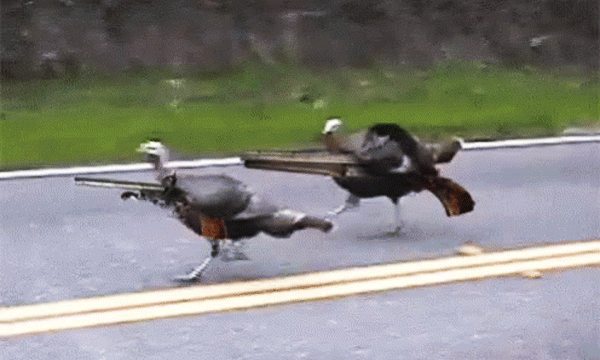
A Turkey Was Chatting With A Bull
A turkey was chatting with a bull.
“I would love to be able to get to the top of that tree”, sighed the turkey,
“But I haven’t got the energy.”
“Well, why don’t you nibble on some of my droppings?” replied the bull.
“They’re packed with nutrients.”
The turkey pecked at a lump of dung and found that it actually gave him enough strength to reach the first branch of the tree.
The next day, after eating some more dung, he reached the second branch. Finally after a fortnight, there he was proudly perched at the top of the tree.
Soon he was promptly spotted by a farmer, who shot the turkey out of the tree.
Moral of the story:
Bullshit might get you to the top, but it won’t keep you there.




































